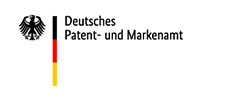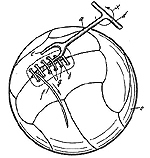The Football (Soccer Ball)
3. A valve on the bladder and how to store it
A football bladder should ideally have a perfect spherical shape. A valve or inflation tube provided on the bladder affects the ideal round shape.
A valve mostly comprises several components which are tougher than the bladder and thus more rigid. This alters ao. the impact properties of a ball considerably. However, the valve should not interfere with the play of the ball.
This poses high requirements on weight balancing, padding and rigidity of the ball and, consequently, of the bladder.
3.1 Hidden valves and inflating tubes
In the early days of the football game, the rubber inflating tube, a stopper or the valve were wedged, laced or pressed in an opening slit of the ball casing and covered by variably shaped leather tongues. The parts were not visible from the exterior. Special fork or spoon shaped tools were required for inserting the bladder into the casing and for lacing and de-lacing. Such tools are presented in patent specifications DE-PS 352 705, DE-PS 362 019, DE-PS 490 946 (Figure 5), DE-PS 494 393 and DE-PS 607 453.
This figure gives an impression of the aspect of the lacing in the outer casing of a football as used in previous decades.
A widely used solution for covering a valve neck is shown in DE-PS 810 365 of 1949. Two bendable leather tongues are placed over each other, on top of the valve, before the opening slit in the outer casing is laced shut. The earlier patents DE-PS 682 057 und DE-PS 536 970 show similar solutions.
Less obvious materials were also used to cover valves. According to DE-PS 366 345 of 1923, for example, a bendable steel plate is attached to the opening slit and used without additional lacing. Regrettably, the patent specification does not discuss the impact of a header with this type of ball. However, the drawing shows fairly clearly how to pull up and how to lodge the inflating tube (Figure 6).
After inflation of a football bladder h, inflating tube k is tied and wedged in the ball casing under steel plate c, shaped like a stadium track. Fork-shaped tool i is used for this purpose.
Loops (DE-PS 484 883) or saw tooth fastenings with virtually woven-in and wedged latches (DE- PS 590 703) were also patented. As a rule, these designs still required additional lacing to definitely close the outer casing.
| Publication number | Year | Title | Brief description |
|---|---|---|---|
| DE-PS 810 365 | 1949 | Sportball | Ball casing laced shut over overlapping leather tongues |
| DE-PS 682 057 | 1935 | Verschluß für den Blaseneinführschlitz an Ballhüllen | Ball casing laced shut over overlapping leather tongues |
| DE-PS 607 453 | 1932 | Vorrichtung zum Verschließen der Hüllen von aufblasbaran Bällen | Lever tool for wedging an inflating tube in a football casing |
| DE-PS 536 970 | 1931 | Sportball, dessen äußere Hülle eine Lochöffnung zum Einführen der inneren, mit Ventil ausgestatteten Luftblase besitzt | Slit shaped casing aperture closed by means of tongues |
| DE-PS 590 703 | 1931 | Fußballhüllenverschluss | Latch type tongue closing of a football casing |
| DE-PS 494 393 | 1929 | Werkzeug zum Einführen des Ventilschlauches in Füßballhüllen | Tunnel shaped tool for wedging an inflating tube in a football casing |
| DE-PS 484 883 | 1928 | Fußballhüllenverschluss | Ball casing closed by a loop attached to a leather tongue |
| DE-PS 490 946 | 1928 | Aus einer zweizinkigen Gabel bestehendes Werkzeug zum Verschnüren von Fußballhüllen | Two-pronged fork tool for lacing football casings |
| DE-PS 366 345 | 1921 | Schnurloser Verschluss für den Öffnungsschlitz in Ballhüllen | Ball casing closed by means of a thin slit steel plate |
| DE-PS 362 019 | 1921 | Werkzeug zum Verschließen und Öffnen von Faust- und Fußbällen | Tongs-like tool for opening a football and storing the inflating tube |
| DE-PS 352 705 | 1921 | Werkzeug zum Einbringen des Füllschlauches von Fußballblasen unter die Hülle | Spoon shaped tool for wedging an inflating tube in a football casing |
3.2 Visible valves
It has become current practice to combine the design of valve and football casing in such a way that the valve is located on the outer face of the ball casing, suitable for inflating the bladder without requiring any preparatory steps.
First steps towards this design were contained in documents DE-PS 273 952 (the valve being visible, but still under lacing) of 1913 and DE-PS 423 534 (valve under lacing accessible from outside) of 1924.
Since the 1930s it has been known to lock both the valve at the bladder and the connected access opening in the ball casing by means of an insertable disc or a bayonet fastening.
DE-PS 590 019 (1933) proposed to embed, in the ball casing, a nut made of hard rubber connected to the bladder valve (Figure 7). It was sealed by means of a hard rubber bolt fitted with a cover piece made of soft rubber. This solution allowed to avoid irregularities of the ball surface that had been related to lacing. At the same time it lowered the risk of injuries inherent in components which were tougher than the ball casing proper.
In addition to its actual function, a valve can be used today as a pressure indicator with a light signal. DE 10 2007 013 025 A1 provides for a pressure sensor arranged within the football, an RGB light emitting diode connected with the sensor and a transparent valve. The colour of the light depends on the pressure at the interior of the ball. Previously, you had to rely on your own feeling to decide whether a ball was getting too soft. Now, a yellow light will signal low pressure. Green light means that pressure is ideal, and red warns you of excessive pressure. This invention must also be seen within the context of the "smart" football, discussed in chapter 6.
| Publication number | Year | Title | Brief description |
|---|---|---|---|
| DE 10 2007 013 025 A1 | 2007 | Konzept zur Erfassung eines Innendrucks eines kompressiblen Gegenstands | Football signalling the interior air pressure by means of LEDs in different colours |
| DE-PS 590 019 | 1930 | Verschluss für Fußballhüllen | Valve cover made of soft rubber, fastened on a hard rubber nut embedded in the ball casing |
| DE-PS 423 534 | 1924 | Fußball mit selbsttätigem Ventil | Valve accessible from outside despite lacing |
| DE-PS 273 952 | 1913 | Luftblasenverschluss für Bälle, z.B. Fußbälle | Valve under lacing, yet openly visible |



